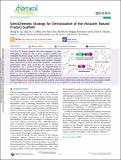Files in this item
GenoChemetic strategy for derivatization of the violacein natural product scaffold
Item metadata
| dc.contributor.author | Lai, Hung-En | |
| dc.contributor.author | Obled, Alan M. C. | |
| dc.contributor.author | Chee, Soo Mei | |
| dc.contributor.author | Morgan, Rhodri M. | |
| dc.contributor.author | Lynch, Rosemary | |
| dc.contributor.author | Sharma, Sunil V. | |
| dc.contributor.author | Moore, Simon J. | |
| dc.contributor.author | Polizzi, Karen M. | |
| dc.contributor.author | Goss, Rebecca J. M. | |
| dc.contributor.author | Freemont, Paul S. | |
| dc.date.accessioned | 2021-10-18T13:30:04Z | |
| dc.date.available | 2021-10-18T13:30:04Z | |
| dc.date.issued | 2021-10-14 | |
| dc.identifier | 276295670 | |
| dc.identifier | 64b2db9f-01c9-4315-a2e4-14196251c4ab | |
| dc.identifier | 85118217163 | |
| dc.identifier | 000726641100008 | |
| dc.identifier.citation | Lai , H-E , Obled , A M C , Chee , S M , Morgan , R M , Lynch , R , Sharma , S V , Moore , S J , Polizzi , K M , Goss , R J M & Freemont , P S 2021 , ' GenoChemetic strategy for derivatization of the violacein natural product scaffold ' , ACS Chemical Biology , vol. Articles ASAP . https://doi.org/10.1021/acschembio.1c00483 | en |
| dc.identifier.issn | 1554-8929 | |
| dc.identifier.other | RIS: urn:9E9BEFBFB5BEAD9F2668E2B7C537239A | |
| dc.identifier.other | ORCID: /0000-0002-9726-0196/work/146014270 | |
| dc.identifier.uri | https://hdl.handle.net/10023/24154 | |
| dc.description | H.E.L. was supported by an Imperial College President’s Ph.D. Scholarship. We thank UKRI EPSRC (EP/K038648/1, EP/L011573/1 to P.S.F.) and the European Union’s Seventh Framework Programme (FP7/2007–2013/ERC grant agreement no. 614779 GenoChemetics to R.J.M.G.) for funding. A.M.C.O. receives funding from EPSRC CRITICAT, EP/L016419/1. | en |
| dc.description.abstract | Natural products and their analogues are often challenging to synthesize due to their complex scaffolds and embedded functional groups. Solely relying on engineering the biosynthesis of natural products may lead to limited compound diversity. Integrating synthetic biology with synthetic chemistry allows rapid access to much more diverse portfolios of xenobiotic compounds, which may accelerate the discovery of new therapeutics. As a proof-of-concept, by supplementing an Escherichia coli strain expressing the violacein biosynthesis pathway with 5-bromo-tryptophan in vitro or tryptophan 7-halogenase RebH in vivo, six halogenated analogues of violacein or deoxyviolacein were generated, demonstrating the promiscuity of the violacein biosynthesis pathway. Furthermore, 20 new derivatives were generated from 5-brominated violacein analogues via the Suzuki–Miyaura cross-coupling reaction directly using the crude extract without prior purification. Herein we demonstrate a flexible and rapid approach to access a diverse chemical space that can be applied to a wide range of natural product scaffolds. | |
| dc.format.extent | 8 | |
| dc.format.extent | 1966611 | |
| dc.language.iso | eng | |
| dc.relation.ispartof | ACS Chemical Biology | en |
| dc.subject | QD Chemistry | en |
| dc.subject | NDAS | en |
| dc.subject.lcc | QD | en |
| dc.title | GenoChemetic strategy for derivatization of the violacein natural product scaffold | en |
| dc.type | Journal article | en |
| dc.contributor.sponsor | EPSRC | en |
| dc.contributor.sponsor | European Research Council | en |
| dc.contributor.institution | University of St Andrews. School of Chemistry | en |
| dc.contributor.institution | University of St Andrews. Biomedical Sciences Research Complex | en |
| dc.contributor.institution | University of St Andrews. EaSTCHEM | en |
| dc.identifier.doi | 10.1021/acschembio.1c00483 | |
| dc.description.status | Peer reviewed | en |
| dc.identifier.grantnumber | EP/L016419/1 | en |
| dc.identifier.grantnumber | GCGXC | en |
This item appears in the following Collection(s)
Items in the St Andrews Research Repository are protected by copyright, with all rights reserved, unless otherwise indicated.

